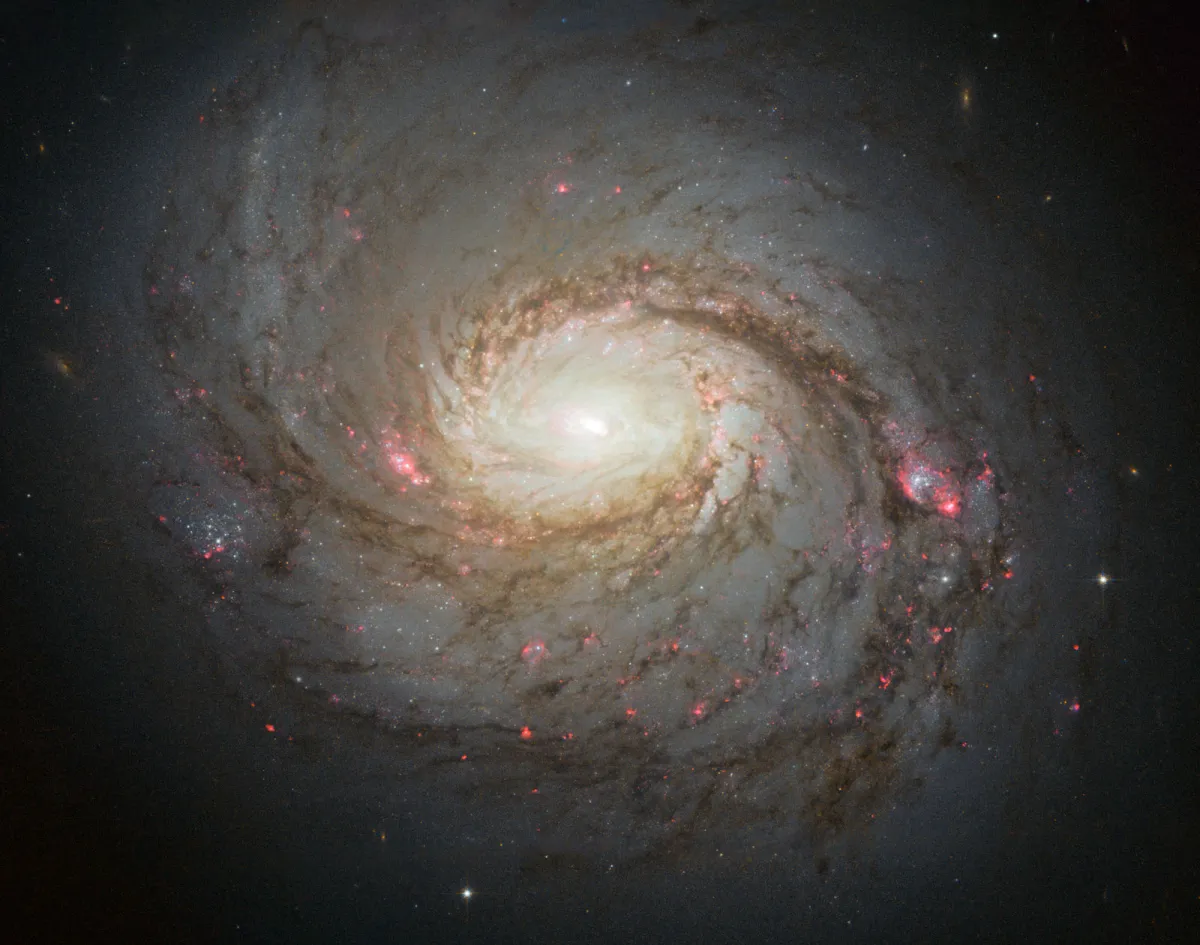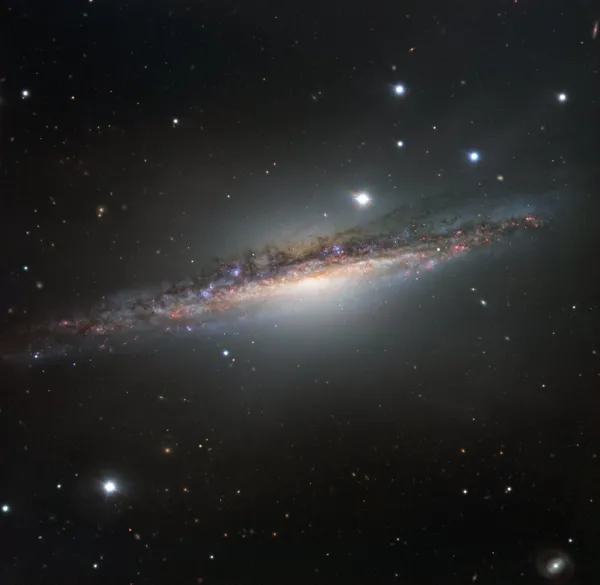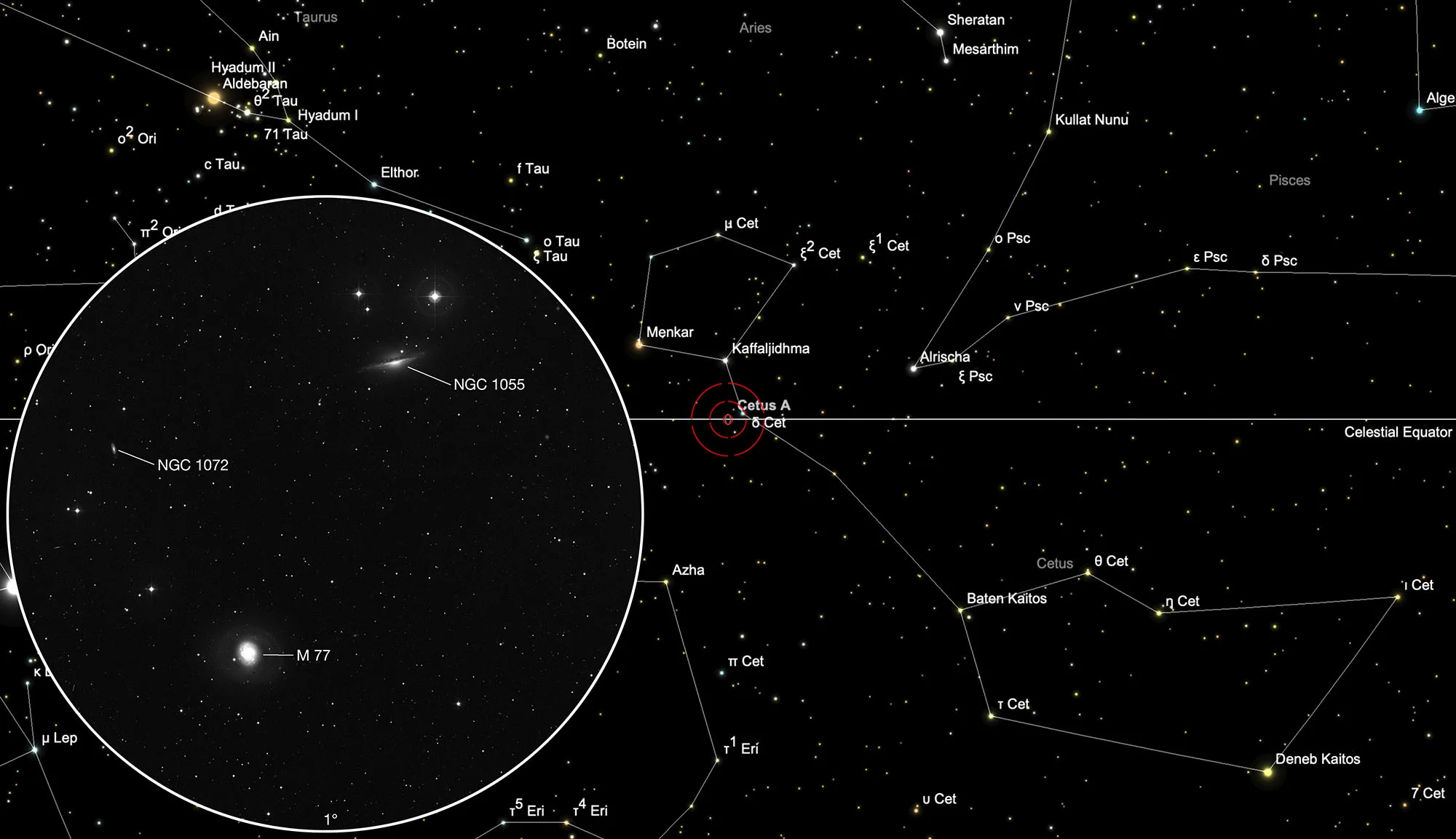Messier 77 (Cetus A) & NGC 1055

History
The galaxy M 77 was discovered by Pierre Méchain on 29 October 1780. Charles Messier verified the observation on 17 December 1780 and wrote: «A cluster of small stars with nebulae, in the whale on the parallels of the star δ [Ceti], third magnitude, which M. Messier estimated only to be fifth. M. Méchain saw the cluster on 29 October 1780 in the form of a mist.» [281] William Herschel also saw a «poorly defined star surrounded by nebula» in his 7 feet focal length telescope in 1783. In his large 10 feet telescope he saw «a kind of greatly enlarged star cluster with a few bright stars in the middle». Only Lord Rosse recognized the spiral nature of this galaxy in 1850. [217] Halton Arp included the galaxy M 77 in his «Atlas of Peculiar Galaxies» published in 1966 as Arp 37, since he suspected small companion galaxies in the bright nodes. A few smaller, much more distant galaxies can also be seen at the edge of M 77. [199]
Physical Properties

At a distance of about 44 million light years, M 77 is the closest and brightest Seyfert galaxy, a group of galaxies with a very active core, lots of hot, ionized, brightly shining gas and a high rate of star formation. In the core there is a supermassive black hole of about 15 million solar masses, which is also a strong source of X-rays and radio radiation. Hence the name «Cetus A». [215]
Only half a degree away is the galaxy NGC 1055, which we can see directly from the side. This was discovered by William Herschel on 18 December 1783. The distance is estimated to be about 45 to 50 million light years and the diameter to about 115'000 light years. It belongs to the same group as M 77. It could also be a starburst galaxy similar to Messier 82. [196]
The small, faint galaxy NGC 1072 is much further away with 114 Mpc (approx. 372 million light years) and does not belong to the group. The best observation time is July to April.
| Name | RA | Dec | Type | bMag | vMag | B-V | SB | Dim | PA | z | D(z) | MD | Dreyer Description | Identification, Remarks |
|---|---|---|---|---|---|---|---|---|---|---|---|---|---|---|
| NGC 1055 | 02 41 45.3 | +00 26 34 | Gx (SBb) | 11.4 | 10.6 | 0.8 | 13.7 | 7.6 × 2.7 | 105 | 0.003314 | 14.00 | 16.630 | pF, cL, iE 80°, bM, * 11 n 1' | WH I 1; h 258; GC 591; UGC 2173; MCG 0-7-81; CGCG 388-95; IRAS 02391+0013; "Sombrero" |
| NGC 1068 | 02 42 40.8 | -00 00 46 | Gx (Sb/P) | 9.6 | 8.9 | 0.7 | 12.8 | 7.1 × 6 | 70 | 0.003793 | 16.02 | 13.500 | vB, pL, iR, sbMrrN | h 262; GC 600; M 77; UGC 2188; MCG 0-7-83; IRAS 02401-0013; KUG 0240-002; Arp 37; 3C 71; CGCG 388-98; Cetus A |
| NGC 1072 | 02 43 31.3 | +00 18 25 | Gx (SBb) | 14.2 | 13.4 | 0.8 | 12.9 | 1.5 × 0.5 | 11 | 0.026744 | 112.9 | eF, vS, R, sev vF st inv | IC 1837; UGC 2208; MCG 0-7-88; IRAS 02409+0005; CGCG 388-103; CGCG 389-1; KUG 0240+000 |
Finder Chart
The galaxy group is located in the constellation Cetus (Whale), less than 1 ° from δ Ceti.
Visual Observation
635 mm Aperture: In a 10 mm Tele Vue Delos eyepiece (254x), you can discern a fine spiral structure in M 77. NGC 1055 displays a dust lane and resembles a face with lips due to the presence of two stars. NGC 1072 appears as a diffuse, slightly elongated spot. — 25" f/4 Obession Dobsonian, Astrofarm Tivoli, Namibia, 15. 9. 2023, Bernd Nies
